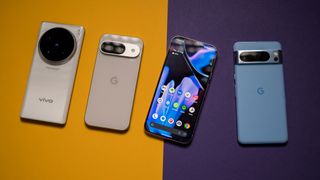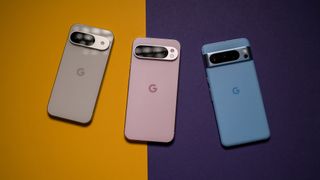The Pixel 9 series sees the introduction of the Tensor G4, and it isn’t markedly different to last year. Google is offering Arm’s latest cores that are clocked marginally higher alongside a new Exynos modem, but other than that, you won’t see any major changes in this year’s silicon.
Obviously, that means the Tensor G4 is largely identical to the G3 in terms of day-to-day performance, and this is in line with my usage of the Pixel 9 and Pixel 9 Pro XL. The phones doesn’t have any issues in most mundane tasks — just like the Pixel 8 series — but push the cameras or launch demanding games, and you’ll see the inherent limitations of the Tensor G4.

As an overview, the G4 has a Cortex X4 core clocked at 3.1GHz, three Cortex A720 cores at 2.6GHz, and the usual set of four efficiency Cortex A520 cores that are designed to go up to 1.92GHz. It has a Mali-G715 GPU that contains six cores, and the base Pixel 9 comes with 12GB of RAM, with the Pro models getting 16GB as standard.
Annoyingly, Google decided to go with UFS 3.1 storage on all variants of the Pixel 9 series, so even if you opt for the 256GB or 512GB models, you won’t get UFS 4.0 storage. This isn’t a problem right now, but with these phones designed to last seven years, the move is shortsighted.
With that out of the way, let’s take a look at how the Tensor G4-based Pixel 9 and Pixel 9 Pro XL scores against their immediate rivals.
Tensor G4 benchmarks: How does it measure up to the Snapdragon 8 Gen 3?
(Image credit: Harish Jonnalagadda / Android Central)
I used Vivo’s incredible X100 Ultra to showcase the Snapdragon 8 Gen 3; it is one of the best phones I used in 2024, and comes with arguably the best overall camera package around today. Qualcomm did a great job in general with the Snapdragon 8 Gen 3, and the chipset has meaningful efficiency gains and offers a sizeable performance boost at the same time.
I’m pitting the Pixel 9and Pixel 9 Pro XL against last year’s Pixel 8 Pro to highlight differences between the Tensor G4 and G3.
Swipe to scroll horizontallyCategoryVivo X100 UltraGoogle Pixel 9 Pro XLGoogle Pixel 9Google Pixel 8 ProPCMark Work 3.0 (Overall)14899130281290712478PCMark Work 3.0 (Web Browsing)1149710322915011575PCMark Work 3.0 (Video Editing)6278760673647356PCMark Work 3.0 (Writing)22368155821539913976PCMark Work 3.0 (Photo Editing)32759192932013318901Geekbench 6 (single-core)217418951210883Geekbench 6 (multi-core)63754111329827483DMark Wild Life Extreme (score)46772483258822513DMark Wild Life Extreme (FPS)28.0114.8615.513.48
The switch to Arm’s latest offerings has allowed the Tensor G4 to deliver better single results in Geekbench, but there’s a clear gulf between the Pixel 9 and 9 Pro XL in this area even though they use the same silicon. Google has a tendency to set different power limits and thermal constraints on its devices, and with the Pixel 9 Pro XL getting a vapor chamber this time, that’s likely the main contributor. The standard Pixel 9 misses out on the vapor chamber, with Google limiting it to the Pro models.
The Tensor G4 continues to be behind the curve when it comes to multi-core scores, and any sustained usage is throttled early. This isn’t the case with devices powered by the Snapdragon 8 Gen 3, but on the upside, the Pixel 9 and 9 Pro XL don’t get anywhere as hot. In fact, they recorded the lowest thermal scores of all devices I tested in 2024, and Google clearly made this a priority with the G4.
Talking about priorities, Google still doesn’t care about gaming, and the Pixel 9 and 9 Pro XL don’t see any meaningful changes in this area. While the Pixel 9 Pro XL had a stability score of 78.7% in 3DMark’s demanding Steel Nomad Light stress test, it had the lowest scores of any flagship.
Tensor G4 day-to-day performance: Better than before, with a gaming caveat

(Image credit: Harish Jonnalagadda / Android Central)
While there aren’t any groundbreaking features in the Tensor G4, it has a few advantages over last year’s G3. The switch to the Exynos 5400 modem is a big deal, and it is noticeable in daily use. My Pixel 8 Pro consistently has issues picking up a cellular signal at home, and the low-power antenna struggles to maintain a reliable connection to the home 5GHz network.
The Pixel 9 Pro XL mitigates this issue; I had no trouble with cellular connectivity in the week I used the device, and it did much better on my home 5GHz network. That said, it still isn’t on par with the Snapdragon X75 modem; all Snapdragon 8 Gen 3-powered devices delivered much better bandwidth, and had a stronger signal.
Google’s latest phones are hobbled when it comes to taking photos, a routine task on most devices. While there’s no shutter lag with regular shots, portrait photos take a second or two to save to the gallery, and it just isn’t possible to take photos in quick succession in this mode. Again, this isn’t an issue on any other high-end phone I tested in 2024, and I took thousands of portrait shots from the Find X7 Ultra, Xiaomi 14 Ultra, Vivo X100 Ultra, and the OnePlus 12.
The Pixel 9 Pro XL is still limited when it comes to gaming, and if anything, it tends to throttle a little sooner than its predecessor. That means you don’t get consistent framerates in demanding titles, and it just doesn’t measure up to the Adreno 750 — it’s at least two generations behind.
That said, overheating isn’t as big a problem this year, with the Pixel 9 Pro XL running cooler than the Pixel 8 Pro in the same titles. The Pixel 9 doesn’t have the same benefits, and it gets warmer in extended gaming sessions — but still nowhere as much as previous generations. It looks like Google set overly aggressive power limits with the Tensor G4 to prevent overheating, and that comes at the cost of stable framerates.
Should you buy the Pixel 9?

(Image credit: Harish Jonnalagadda / Android Central)
After a week of use, it’s clear that Google made a few welcome tweaks to the hardware. While the Pixel 9 and Pixel 9 Pro XL still don’t measure up to the likes of the X100 Ultra, they are better than previous years, and there aren’t many annoyances in daily use. The biggest issue is still around gaming performance — these phones just aren’t built to play visually-intensive games.
If you don’t care about that, there’s certainly a lot to like with the new Pixels. The build quality is much better than previous generations, and there are decent efficiency gains over the Tensor G3. Most of all, it’s the AI features that give the Pixel 9 and 9 Pro XL a considerable edge over other flagships, and the cameras continue to be the most consistent of any device.

Overall, the Pixel 9 Pro XL is brilliant. The internal hardware may not be the best around, but you get terrific AI-backed utilities that make a real difference in daily use, and the cameras are great.





GIPHY App Key not set. Please check settings